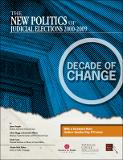| dc.description.abstract |
Reseña: State judicial elections have been transformed during the past decade. The story of America’s2000–2009 high court contests—tens of millions of dollars raised by candidates from parties whomay appear before them, millions more poured in by interest groups, nasty and misleading ads, andpressure on judges to signal courtroom rulings on the campaign trail—has become the new normal.For more than a decade, partisans and special interests of all stripes have been growing more organizedin their efforts to use elections to tilt the scales of justice their way. Many Americans have come tofear that justice is for sale.Unlike previous editions, which covered only the most recent election cycle, this fifth edition of the“New Politics of Judicial Elections” looks at the 2000–2009 decade as a whole. By tallying the numbersand “connecting the dots” among key players over the last five election cycles, this report offersa broad portrait of a grave and growing challenge to the impartiality of our nation’s courts. Thesetrends include:The explosion in judicial campaign spending, much of ?? it poured in by “superspender” organizations seeking to sway the courts;?? The parallel surge of nasty and costly TV ads as a prerequisite to gaining a stateSupreme Court seat;?? The emergence of secretive state and national campaigns to tilt state SupremeCourt elections;?? Litigation about judicial campaigns, some of which could boost special-interestpressure on judges;?? Growing public concern about the threat to fair and impartial justice—and supportfor meaningful reforms.State judicial elections have been transformed during the past decade. The story of America’s 2000–2009 high court contests—tens of millions of dollars raised by candidates from parties who may appear before them, millions more poured in by interest groups, nasty and misleading ads, and pressure on judges to signal courtroom rulings on the campaign trail—has become the new normal. For more than a decade, partisans and special interests of all stripes have been growing more organized in their efforts to use elections to tilt the scales of justice their way. Many Americans have come to fear that justice is for sale.Unlike previous editions, which covered only the most recent election cycle, this fifth edition of the “New Politics of Judicial Elections” looks at the 2000–2009 decade as a whole. By tallying the numbers and “connecting the dots” among key players over the last five election cycles, this report offers a broad portrait of a grave and growing challenge to the impartiality of our nation’s courts. These trends include:The explosion in judicial campaign spending, much of ?? it poured in by “super spender” organizations seeking to sway the courts;?? The parallel surge of nasty and costly TV ads as a prerequisite to gaining a state Supreme Court seat;?? The emergence of secretive state and national campaigns to tilt state Supreme Court elections;?? Litigation about judicial campaigns, some of which could boost special-interest pressure on judges;?? Growing public concern about the threat to fair and impartial justice—and support for meaningful reforms. |

